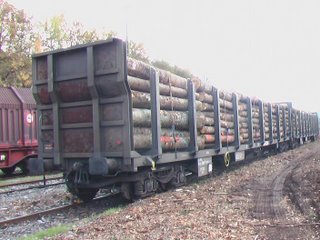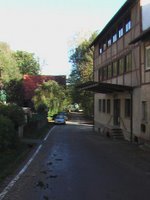
On Wednesday I had an appointment in Nagold, a town in the Black Forest. I went by train, of course.
Nagold is about ten kilometres south of Wildberg, where the fictional Körschtalbahn meets the real Nagoldtalbahn. It used to have its own narrow gauge railway running to Altensteig.
One of the reasons given for the demise of Narrow Gauge is the transhipment cost. It costs too much to tranship freight from standard gauge to narrow, and vice versa. The picture above shows a train of wagons (From Belgium, if you’re wondering), which have just been shunted into that shed for unloading; there’s apparently a freight train to Nagold, carrying different things every one or two days. The steel is put onto a truck and driven to a company based in Rohrdorf, who are steel distributors, and if that isn’t transhipment, I don’t know what is.
Rohrdorf is on the route of the old Narrow Gauge line. How much easier it would have been to simply shove those steel wagons onto transporters, or just transfer the load, onto narrow gauge wagons instead...

There are also wood trains. These Austrian wagons have clearly just been loaded, which conforms that the wood train I saw being loaded at Nagold on my last fleeting visit wasn't a one off.
I’ve got a few more pictures, which are on the
Flickr gallery. I also got a brief look at Wildberg on the way through. It is a lot more mountainous than I thought, but there is a small valley running into the hills, which could easily be part of the Körschtalbahn. And the buildings are very distinctive and I didn’t have time to take photos.
Which just means I’ll have to go back again…
 After 3 attempts the cab sides for G1 are ready. I’ve not glued the lot together, but I couldn’t resist having a dry run to see how it looks. Hopefully the dodgy joins in the cab will disappear when it’s fixed properly. I don’t know what happened to the end of the short bonnet but it won’t go straight. The exhaust is a drinking straw, and I may try for a bigger diameter version. You’ll notice I’ve chickened out of interior details so far, and the railings. I think I need to move the buffers up a bit to fit the DG coupling in
After 3 attempts the cab sides for G1 are ready. I’ve not glued the lot together, but I couldn’t resist having a dry run to see how it looks. Hopefully the dodgy joins in the cab will disappear when it’s fixed properly. I don’t know what happened to the end of the short bonnet but it won’t go straight. The exhaust is a drinking straw, and I may try for a bigger diameter version. You’ll notice I’ve chickened out of interior details so far, and the railings. I think I need to move the buffers up a bit to fit the DG coupling in



